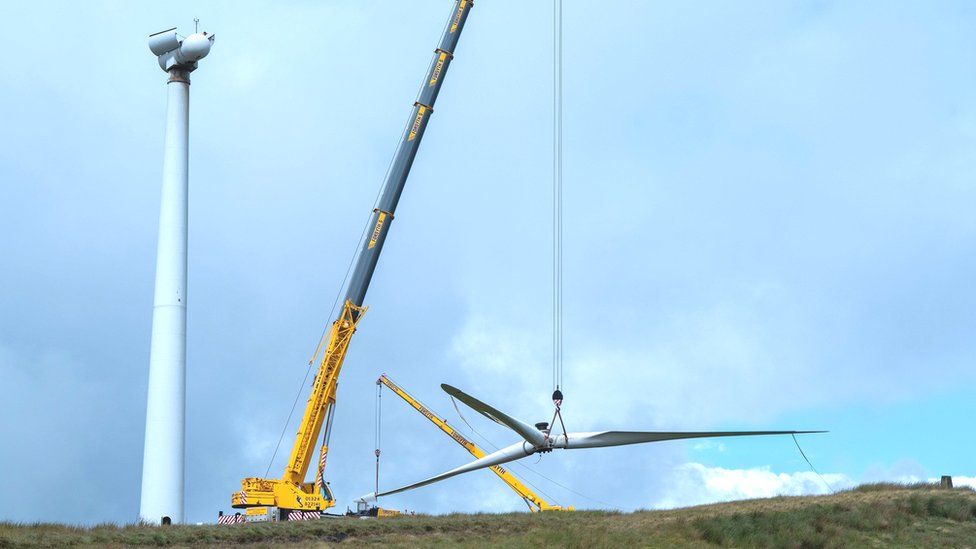ARTICLE AD BOX
 Image source, ScottishPower Renewables
Image source, ScottishPower Renewables
The old wind turbines at Hagshaw Hill wind farm in Scotland have been dismantled
By Michael Winrow
Technology of Business reporter
The cranes moved in last year at Hagshaw Hill, Scotland's oldest commercial wind farm.
They were there to continue the dismantling of wind turbines that had been generating electricity for the last 28 years.
A similar scene can be witnessed across the world as the first wave of wind turbines built in the late 1990s and early 2000s are decommissioned.
In the case of Hagshaw Hill, the existing turbines will be replaced with taller and more efficient ones that can generate up to 10 times more electricity.
But working out what to do with the old turbines is challenging.
Between 85 and 95% of a turbine's materials, such as steel, aluminium, and copper, can be easily recycled, but the blades are a different matter.
Made of fibreglass they are covered with a tough epoxy resin, designed to withstand years of hammering by the elements.
These durable qualities make breaking down the blades for recycling a tricky process.
Image source, Getty Images
Image caption,Wind turbine blades are built to last which makes them hard to recycle
Traditional solutions include using pieces of decommissioned blades in cement kilns to manufacture cement, though this can be an energy intensive process.
Blades are also commonly disposed of in landfill sites, but this option is becoming increasingly less feasible with a number of countries, notably Germany and the Netherlands, banning the practice.
Innovative solutions such as repurposing blades into playgrounds or bike sheds have been shown to be effective at a local level but, with some experts predicting up to 43 million tonnes of wind turbine blade waste by 2050, there is a pressing need for a system that will work on a bigger scale.
Scientists and start-ups are working on the problem, with many focusing on tackling the challenge of breaking down the materials used in the blades.
"At the end of life, if we're going to get any value out of the materials, we need to be able to separate the fibres from the resin in some way or another," Dr Claire Barlow, a sustainability and materials engineer, from the University of Cambridge tells me.
One approach showing promise uses a technique developed by the University of Strathclyde.
It involves breaking the blades down into small pieces and feeding them into a very hot air stream.
The process separates the glass fibre from the resin. The glass fibre can then be collected, treated and reused, explains Malcolm Forsyth who leads Project PRoGrESS, which aims to commercialise the technology.
The project, which kicked off in 2022, is working on a pilot plant that's due to be operational in the first half of this year - though it's hit some difficulties.
"The major challenge for the project team has been the rapid escalation of material costs partly due to the Russia and Ukraine war, as well as global inflation," according to Mr Forsyth.
Similar solutions are being tested elsewhere that use different methodologies but have the same overarching goal of breaking down the materials used in wind turbine blades.
Image source, Vestas Wind Systems
Image caption,Denmark's Vestas is Europe's biggest maker of wind turbines
Danish company Vestas, the largest wind turbine producer in Europe, announced last year an approach that uses a liquid chemical solution to break down the blades into materials which can then potentially be used to make new blades.
A major advantage of this approach, according to Vestas, is that it uses widely available chemicals, though details haven't been disclosed. The process has the added benefit of not requiring energy-intensive high temperatures.
Both of these traits hint at potential scalability, with the company claiming to have recycled 475 end-of-life blades in 2022.
If technologies such as these succeed "then not only can we solve the problem of new waste coming through, but we can also actually tackle historic waste," according to Dr Barlow.
Historic blade waste currently in landfill could be recycled, as could waste which has been placed in storage awaiting a solution.
At Hagshaw Hill a number of wind turbines have been kept in storage while ScottishPower Renewables decides what to do with them.
Perhaps the future will be to make turbine blades that are easier to break down.
A number of companies are working on building blades made out of materials less reliant on the difficult to recycle fibreglass and epoxy resin. However at this stage, the vast majority of blades continue to be made of these traditional materials.
The next few years will determine whether the recycling technology under development can be scaled-up to a useful size, without harming the environment.
As Dr Barlow puts it "that really is the silver bullet."

 10 months ago
20
10 months ago
20








 English (US) ·
English (US) ·